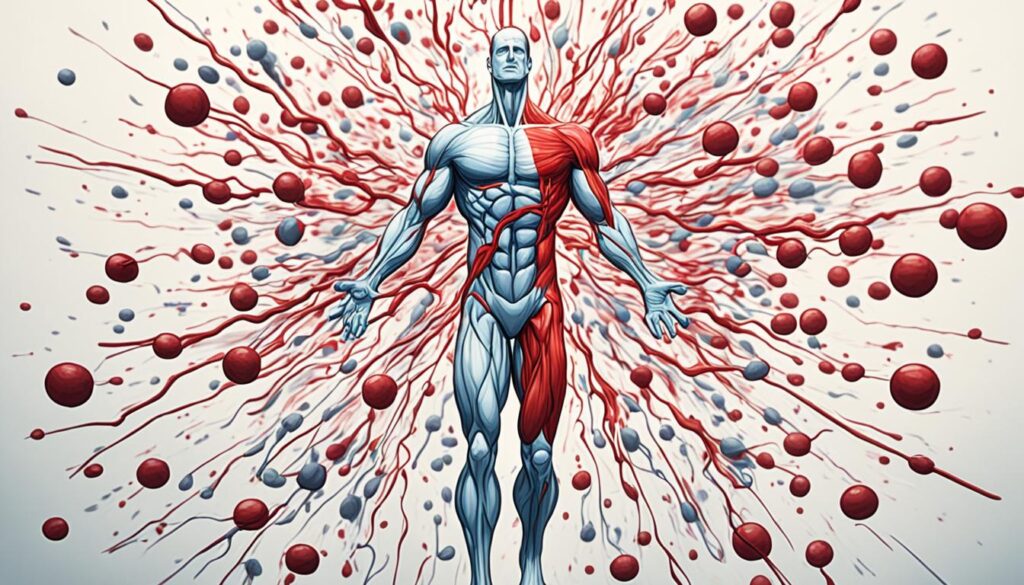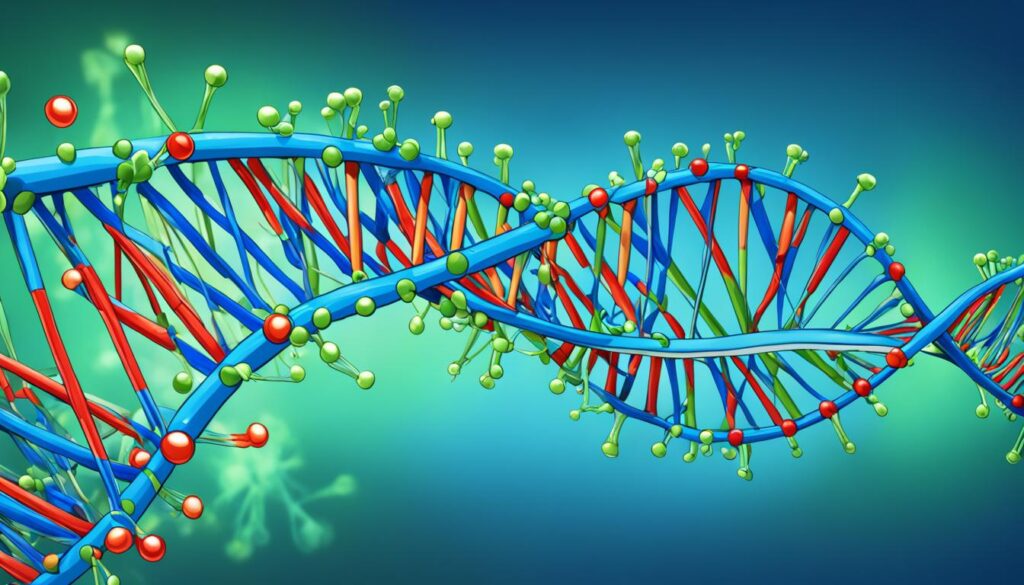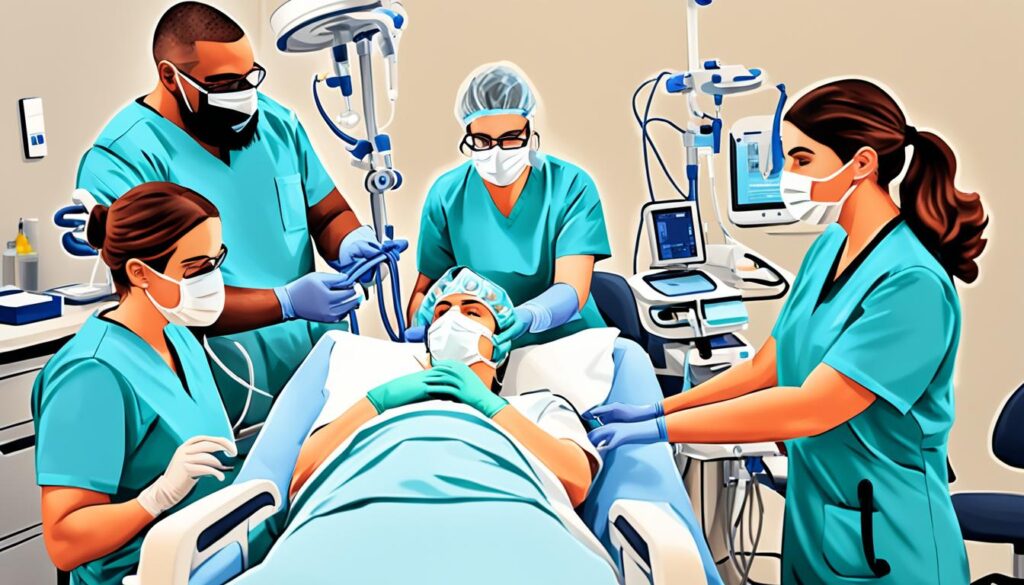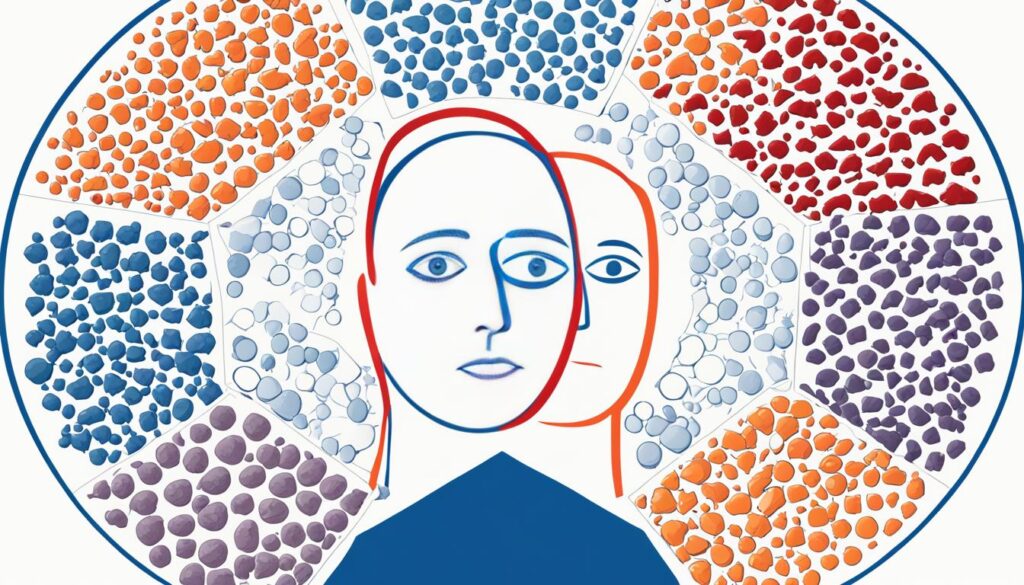Welcome to our comprehensive guide on Ataxia Telangiectasia, a rare genetic disorder that affects individuals worldwide, including those in India. In this article, we will delve into the fundamentals of this condition, including its symptoms, causes, and management.
Ataxia Telangiectasia, also known as AT, is characterized by progressive cerebellar degeneration, oculocutaneous telangiectasias, immunodeficiency, recurrent sinopulmonary infections, radiation sensitivity, premature aging, and an increased susceptibility to cancer. It is caused by a mutation in the ataxia telangiectasia mutated (ATM) gene.
This comprehensive guide will provide valuable insights into the symptoms of AT, the underlying causes, and the multidisciplinary approach to its management. Additionally, we will explore the prevalence, prognosis, and various neurological, ocular, and cutaneous manifestations associated with this genetic disorder.
Whether you are a patient, a caregiver, or simply seeking information on AT, this article will equip you with the knowledge you need to better understand this complex condition.
Table of Contents
ToggleSymptoms of Ataxia Telangiectasia
Ataxia telangiectasia (AT) is characterized by a range of symptoms that affect various systems in the body. The most common symptoms include:
- Progressive cerebellar degeneration: AT leads to the degeneration of the cerebellum, a part of the brain responsible for coordinating movements. This results in problems with balance, coordination, and fine motor skills.
- Oculocutaneous telangiectasias: These are dilated blood vessels that appear on the skin and mucous membranes, particularly around the eyes and cheeks. They can also occur in other areas of the body, such as the ears and nose.
- Immunodeficiency: AT affects the immune system, leading to an increased susceptibility to recurrent sinopulmonary infections. These infections can range from respiratory tract infections to more severe respiratory complications.
- Radiation sensitivity: Individuals with AT are highly sensitive to the effects of ionizing radiation, such as medical imaging and radiotherapy. They may experience more significant side effects from radiation exposure.
- Premature aging: AT is associated with premature aging features, including gray hair, wrinkled skin, and a loss of muscle tone.
- Cancer susceptibility: AT patients have an increased risk of developing lymphoid cancers, such as leukemia and lymphoma. Regular cancer screening is essential for early detection and treatment.
In addition to these primary symptoms, individuals with AT may also experience growth failure, poor pubertal development, insulin-resistant diabetes, lung diseases, cutaneous abnormalities, and cardiovascular diseases. Neurological symptoms, including ataxia (uncoordinated movements), dysarthria (impaired speech), abnormal eye movements, and muscle hypotonia, are also common.

Causes of Ataxia Telangiectasia
Ataxia telangiectasia (AT) is a genetic disorder caused by a mutation in the ataxia telangiectasia mutated (ATM) gene. The ATM gene is responsible for encoding the ATM protein, which plays a critical role in the repair of DNA double-strand breaks (DSB). Mutations in the ATM gene lead to a dysfunctional ATM protein, resulting in chromosomal instability, DNA repair disorders, and immune deficiencies.
The loss of ATM protein function affects various physiological processes, including DNA replication, meiosis, mitosis, and immunoglobulin class switching. This genetic mutation disrupts the proper repair of DNA double-strand breaks, leading to chromosomal instability and an increased risk of genetic abnormalities.

The ATM gene mutation is inherited in an autosomal recessive manner, meaning that both parents must carry a copy of the mutated gene for the condition to occur in their child. Individuals with only one copy of the mutated gene are carriers and do not typically exhibit symptoms of AT.
Chromosomal Instability and DNA Repair Disorders
The dysfunction of the ATM protein results in chromosomal instability, which refers to the tendency of chromosomes to undergo structural abnormalities or gain or lose genetic material. This instability can lead to further DNA damage and genetic mutations.
Additionally, without functional ATM protein, DNA repair processes are impaired. The ATM protein plays a crucial role in initiating and coordinating the repair of DNA double-strand breaks. These breaks can occur naturally during DNA replication or as a result of exposure to radiation or other external factors. Failure to repair these breaks effectively can result in the accumulation of DNA damage and a higher risk of genetic mutations.
Overall, the genetic mutation in the ATM gene disrupts essential DNA repair mechanisms and causes chromosomal instability, leading to the characteristic features of ataxia telangiectasia.
| Causes of Ataxia Telangiectasia | Effect |
|---|---|
| Mutation in the ATM gene | Dysfunctional ATM protein |
| Chromosomal instability | Genetic abnormalities and mutations |
| DNA repair disorders | Accumulation of DNA damage and mutations |
Management of Ataxia Telangiectasia
The management of ataxia telangiectasia (AT) requires a comprehensive and multidisciplinary approach to address the various symptoms and complications associated with the disorder. A team of healthcare professionals, including neurologists, immunologists, pulmonologists, and oncologists, collaborate to provide the best possible care for individuals with AT.
Supportive Care:
Supportive care plays a crucial role in managing the symptoms and improving the quality of life for AT patients. This includes addressing motor function impairments, speech and swallowing difficulties, respiratory complications, and the risk of developing cancer.
Physical Therapy:
Physical therapy is employed to improve motor function, enhance coordination, and promote overall physical well-being. Therapeutic exercises and activities tailored to address specific physical limitations can help individuals with AT maintain mobility and independence for as long as possible.
Speech Therapy:
Speech therapy focuses on improving speech and communication skills. Speech therapists work with AT patients to address difficulties in articulation, language development, voice control, and swallowing function. This helps individuals with AT communicate effectively and prevents complications related to dysarthria and dysphagia.
Respiratory Support:
Respiratory complications are common in AT, and respiratory support plays a vital role in managing these issues. This may include interventions aimed at improving lung function, managing chronic pulmonary diseases, and preventing respiratory infections. Respiratory therapy, pulse oximetry monitoring, and use of medical devices, such as respiratory assistive devices, may be recommended by pulmonologists.
Cancer Screening:
Due to the increased susceptibility to cancer in individuals with AT, regular cancer screenings are essential for early detection and intervention. Routine screenings, such as imaging studies and laboratory tests, are used to identify any signs of malignancy. Oncologists closely monitor AT patients and develop personalized cancer surveillance plans based on individual risk factors.
Genetic Counseling:
Genetic counseling is an integral part of the management of AT. Genetic counselors provide information and guidance regarding the genetic inheritance pattern of AT, as well as the potential risks for family members. They help individuals and their families make informed decisions about family planning, genetic testing, and the implications of AT in future generations.

| Management Approach | Benefits |
|---|---|
| Supportive Care | – Addresses symptoms and complications – Improves quality of life |
| Physical Therapy | – Enhances motor function and coordination – Maintains mobility and independence |
| Speech Therapy | – Improves speech and swallowing abilities – Enhances communication skills |
| Respiratory Support | – Manages respiratory complications – Improves lung function and prevents infections |
| Cancer Screening | – Detects malignancies at an early stage – Facilitates timely intervention |
| Genetic Counseling | – Provides information about genetic inheritance – Assists in family planning and decision-making |
By utilizing a multidisciplinary approach that incorporates supportive care, physical therapy for ataxia, speech therapy, respiratory support, cancer screening, and genetic counseling, the management of ataxia telangiectasia aims to optimize the well-being and overall health of individuals living with this rare genetic disorder.
Prevalence and Prognosis of Ataxia Telangiectasia
Understanding the prevalence and prognosis of ataxia telangiectasia (AT) is crucial in comprehending the impact of this rare genetic disorder. While the prevalence of AT is estimated to be less than 1-9 cases per 100,000 individuals, it may be higher in consanguineous populations or those with a founder effect. AT is associated with a poor prognosis, with a median survival of 25 years.
The two most common causes of death in AT patients are chronic pulmonary diseases and malignancy, particularly lymphoid cancers. These life-threatening complications contribute to the challenges faced by individuals with AT and their families. However, it is important to note that the clinical and laboratory differences among AT patients indicate genotypic and phenotypic variations, with some mutations leading to a milder phenotype.
Various factors, such as genetic and environmental modifiers, can influence the progression and severity of the disease. Understanding these factors is crucial in developing effective management strategies and providing appropriate support to patients and their families.
Now let’s take a closer look at the prevalence and prognosis of AT through the following table:

| Aspect | Data |
|---|---|
| Prevalence | Less than 1-9 cases per 100,000 individuals |
| Incidence | Higher in consanguineous populations or those with a founder effect |
| Poor Prognosis | Median survival of 25 years |
| Causes of Death | Chronic pulmonary diseases and malignancy, particularly lymphoid cancers |
Neurological Manifestations of Ataxia Telangiectasia
Neurological manifestations are a prominent feature of ataxia telangiectasia (AT). AT is characterized by progressive neurodegeneration and cerebellar dysfunction, leading to various symptoms that significantly affect daily life.
Ataxia
One of the primary neurological symptoms experienced by individuals with AT is ataxia, which refers to uncoordinated movements and difficulties with balance and coordination. These motor impairments can make simple tasks such as walking, writing, and buttoning a shirt challenging.
Oculomotor Abnormalities
Another characteristic feature of AT is oculomotor abnormalities, which result in abnormal eye movements. These eye movements may be involuntary, jerky, or slow, impacting visual perception and coordination. It can lead to difficulties in visually tracking objects or reading.
Dysarthria
Dysarthria, a condition characterized by impaired speech, is also commonly observed in AT patients. It affects the muscles involved in speech production, making it difficult to articulate words clearly. Speech may be slurred, slow, and difficult to understand.
Muscle Hypotonia
Individuals with AT often experience muscle hypotonia, which is a decreased muscle tone. Muscles may appear floppy or feel weak and lack the necessary tension required for proper movement. This can further contribute to difficulties with coordination and motor control.
Neuroimaging studies have revealed cerebellar atrophy and degeneration, particularly in the vermis and hemispheres, further supporting the neurodegenerative nature of AT. It is important to note that microcephaly, which refers to a small head size, is generally not present in individuals with AT.
Ocular and Cutaneous Characteristics of Ataxia Telangiectasia
Ocular and cutaneous characteristics are common in ataxia telangiectasia (AT). Ocular telangiectasias, dilated blood vessels in the eyes, are a hallmark feature of AT. These telangiectasias typically appear after the onset of neurological symptoms and can cause visual disturbances. Skin telangiectasias may also be present in some AT patients, particularly on sun-exposed areas of the skin. The telangiectasias do not bleed or itch but may be misdiagnosed as chronic conjunctivitis or allergies due to their appearance. In some cases, telangiectasias can also be found in the pharyngeal wall and deep inside the brain.
| Characteristics | Occurrences |
|---|---|
| Ocular Telangiectasias | Presents in the eyes as dilated blood vessels |
| Visual Disturbances | May cause vision problems |
| Skin Telangiectasias | May appear on sun-exposed areas of the skin |
| Misdiagnosis | Can be mistaken for chronic conjunctivitis or allergies |
| Pharyngeal Telangiectasias | May be found in the pharyngeal wall |
| Intracranial Telangiectasias | Can occur deep inside the brain |
Respiratory Complications in Ataxia Telangiectasia
Respiratory complications pose significant challenges for individuals with ataxia telangiectasia (AT). Due to weakened immunity and underlying abnormalities in DNA damage repair mechanisms, AT patients are more susceptible to respiratory infections, including sinopulmonary infections. As they age, the risk of developing chronic lung diseases increases, further exacerbating respiratory difficulties.
The immunodeficiency associated with AT plays a central role in the heightened susceptibility to respiratory infections. Reduced or absent levels of immunoglobulin G2 (IgG2) and defects in immunoglobulin class switching leave individuals vulnerable to recurrent infections. The compromised immune response impairs the ability to fight off respiratory pathogens and leads to increased respiratory complications.
In addition to immunodeficiency, AT patients also experience lung diseases that contribute to respiratory complications. These diseases encompass bronchiectasis, interstitial lung disease/pulmonary fibrosis, and neuromuscular disorders affecting respiratory function. Chronic inflammation and oxidative stress further compound the development and progression of these lung conditions.
To gain a better understanding of the respiratory complications in AT, consider the following:
Respiratory Infections in Ataxia Telangiectasia
Recurrent sinopulmonary infections, such as bronchitis and pneumonia, are a common occurrence in AT patients. Impaired immune responses, coupled with decreased mucociliary clearance, create an environment conducive to infection. The respiratory system becomes a target for various pathogens, leading to persistent infections that adversely affect lung function and overall well-being.
Chronic Lung Diseases in Ataxia Telangiectasia
Over time, AT patients may develop chronic lung diseases that significantly impact respiratory health. Bronchiectasis, characterized by the abnormal widening of the bronchial tubes, can lead to chronic cough, excessive mucus production, and recurrent respiratory infections. Interstitial lung disease/pulmonary fibrosis, marked by scarring and thickening of lung tissue, impairs lung function and reduces oxygen exchange. Neuromuscular disorders affecting respiratory function, such as diaphragmatic weakness, contribute to respiratory difficulties.
Management of Respiratory Complications
The management of respiratory complications in AT involves a comprehensive approach aimed at supporting lung health and preventing further deterioration. This may include:
- Regular monitoring of lung function and respiratory infections through medical assessments
- Appropriate antimicrobial therapies to combat infections
- Chest physiotherapy techniques to promote mucus clearance from the lungs
- Oxygen therapy or mechanical ventilation in severe cases
- Immunoglobulin replacement therapy to bolster immune response
With strategic management and proactive measures, individuals with AT can mitigate the impact of respiratory complications and improve their overall quality of life.
Comparison of Respiratory Complications in Ataxia Telangiectasia
| Respiratory Complications | Characteristics |
|---|---|
| Recurrent Sinopulmonary Infections | Frequent episodes of respiratory infections, such as bronchitis and pneumonia |
| Bronchiectasis | Abnormal widening of the bronchial tubes, chronic cough, excessive mucus production, recurrent respiratory infections |
| Interstitial Lung Disease/Pulmonary Fibrosis | Scarring and thickening of lung tissue, impaired lung function, reduced oxygen exchange |
| Neuromuscular Disorders Affecting Respiratory Function | Diaphragmatic weakness, compromised respiratory function |
Understanding the respiratory complications in ataxia telangiectasia is essential for effective management and targeted interventions. By addressing immunodeficiency, providing supportive care, and closely monitoring respiratory health, individuals with AT can experience improved respiratory outcomes and enhanced overall well-being.
Cancer Susceptibility in Ataxia Telangiectasia
Individuals with Ataxia Telangiectasia (AT) are more susceptible to developing cancer, particularly lymphoid cancers. Due to this increased risk, regular cancer screening is highly recommended to detect any malignancies at an early stage.
AT is characterized by a genetic predisposition to cancer development, which is further exacerbated by impaired DNA repair mechanisms. The underlying genetic mutations in the ataxia telangiectasia mutated (ATM) gene contribute to the increased risk of cancer.
Hematopoietic malignancies, including leukemia and lymphoma, are more common in AT patients. Additionally, ATM mutations have also been associated with an increased risk of breast cancer.
To effectively manage and treat cancer in individuals with AT, genetic counseling and early cancer detection play a critical role. These measures help in understanding the genetic factors contributing to cancer susceptibility and allow for the implementation of appropriate treatment strategies.
Overall, the recognition of the heightened cancer risk in AT patients underscores the importance of proactive cancer screening and genetic counseling for improved management and outcomes.
| Cancer Type | Risk in AT Patients |
|---|---|
| Lymphoid Cancers (Leukemia, Lymphoma) | Higher risk compared to the general population |
| Breast Cancer | Increased risk associated with ATM mutations |
Conclusion
Ataxia telangiectasia (AT) is a rare genetic disorder that affects various aspects of a person’s health, including their neurological function, immune system, and susceptibility to cancer. The condition is caused by a mutation in the ataxia telangiectasia mutated (ATM) gene, leading to progressive cerebellar degeneration, oculocutaneous telangiectasias, and immunodeficiency.
Managing AT requires a multidisciplinary approach, involving a team of healthcare professionals who provide supportive care to address the symptoms and complications associated with the disorder. Physical therapy and speech therapy can help improve motor skills and address speech difficulties. Regular cancer screening plays a crucial role in the early detection and management of potential malignancies in AT patients.
Unfortunately, the prognosis for AT remains poor, with a median survival of 25 years. However, advancements in medical care and research may continue to improve the management and quality of life for individuals with AT. Genetic counseling is an essential aspect of AT management, as it provides information about the genetic inheritance pattern and potential risks for family members.
In conclusion, AT is a complex genetic disorder that affects multiple systems in the body. Although the prognosis is challenging, early detection, supportive care, and regular monitoring can help individuals with AT lead fulfilling lives and manage their symptoms effectively.
FAQ
What is Ataxia Telangiectasia?
Ataxia Telangiectasia (AT) is a genetic disorder characterized by progressive cerebellar degeneration, oculocutaneous telangiectasias (dilated blood vessels on the skin and mucous membranes), immunodeficiency, recurrent sinopulmonary infections, radiation sensitivity, premature aging, and susceptibility to cancer development.
What are the symptoms of Ataxia Telangiectasia?
The symptoms of Ataxia Telangiectasia include progressive cerebellar degeneration, oculocutaneous telangiectasias, immunodeficiency leading to recurrent sinopulmonary infections, radiation sensitivity, premature aging, and an increased susceptibility to the development of lymphoid cancers. AT patients may also experience growth failure, poor pubertal development, gonadal atrophy, insulin-resistant diabetes, lung diseases, cutaneous abnormalities, and cardiovascular diseases. Neurological symptoms such as ataxia, dysarthria, abnormal eye movements, and muscle hypotonia are also common.
What causes Ataxia Telangiectasia?
Ataxia Telangiectasia is caused by a mutation in the ataxia telangiectasia mutated (ATM) gene. This gene is responsible for encoding the ATM protein, which plays a critical role in the repair of DNA double-strand breaks (DSB). Mutations in the ATM gene lead to a dysfunctional ATM protein, resulting in chromosomal instability, DNA repair disorders, and immune deficiencies.
How is Ataxia Telangiectasia managed?
The management of Ataxia Telangiectasia primarily focuses on providing supportive care to address the various symptoms and complications associated with the disorder. A multidisciplinary approach is often necessary, involving a team of healthcare professionals such as neurologists, immunologists, pulmonologists, and oncologists. Treatment may include physical therapy to improve motor function, speech therapy to address speech and swallowing difficulties, respiratory support to manage respiratory complications, and regular cancer screening to detect early signs of malignancy. Genetic counseling is also an important aspect of management to provide information about the genetic inheritance pattern and potential risks for family members.
What is the prevalence and prognosis of Ataxia Telangiectasia?
The prevalence of Ataxia Telangiectasia is estimated to be less than 1-9 cases per 100,000 individuals. However, the incidence may be higher in consanguineous populations or those with a founder effect. AT has a poor prognosis, with a median survival of 25 years. The two most common causes of death in AT patients are chronic pulmonary diseases and malignancy, particularly lymphoid cancers.
What are the neurological manifestations of Ataxia Telangiectasia?
Neurological manifestations are a prominent feature of Ataxia Telangiectasia. AT is characterized by progressive neurodegeneration and cerebellar dysfunction, leading to symptoms such as ataxia (uncoordinated movements), oculomotor abnormalities (abnormal eye movements), dysarthria (impaired speech), and muscle hypotonia. Patients may also experience abnormal involuntary movements, including chorea, dystonia, and tremors.
What are the ocular and cutaneous characteristics of Ataxia Telangiectasia?
Ocular and cutaneous characteristics are common in Ataxia Telangiectasia. Ocular telangiectasias, dilated blood vessels in the eyes, are a hallmark feature of AT. These telangiectasias typically appear after the onset of neurological symptoms and can cause visual disturbances. Skin telangiectasias may also be present in some AT patients, particularly on sun-exposed areas of the skin.
What are the respiratory complications in Ataxia Telangiectasia?
Respiratory complications are a significant concern in Ataxia Telangiectasia. AT patients are prone to recurrent sinopulmonary infections and may develop chronic lung disease as they age. These respiratory complications are primarily due to the immunodeficiency associated with AT, as well as abnormalities in DNA damage repair mechanisms, premature aging, chronic inflammation, and oxidative stress.
Are Ataxia Telangiectasia patients more susceptible to cancer?
Yes, Ataxia Telangiectasia patients have an increased susceptibility to cancer development, especially lymphoid cancers. Regular cancer screening is recommended to detect any malignancies at an early stage. The underlying genetic predisposition, along with the impairment of DNA repair mechanisms, contributes to the increased cancer risk.
What is the conclusion about Ataxia Telangiectasia?
Ataxia Telangiectasia is a rare genetic disorder characterized by progressive cerebellar degeneration, oculocutaneous telangiectasias, immunodeficiency, recurrent sinopulmonary infections, radiation sensitivity, premature aging, and an increased susceptibility to cancer. The disease is caused by a mutation in the ataxia telangiectasia mutated (ATM) gene. The management of AT involves a multidisciplinary approach, focusing on supportive care for various symptoms and complications. The prognosis of AT is poor, with a median survival of 25 years. Regular cancer screening and genetic counseling are crucial for early detection and management of cancer in AT patients.
Source Links
About The Author

This article is medically reviewed by Dr. Chandril Chugh, Board-Certified Neurologist, providing expert insights and reliable health information.
Dr. Chandril Chugh is a U.S.-trained neurologist with over a decade of experience. Known for his compassionate care, he specializes in treating neurological conditions such as migraines, epilepsy, and Parkinson’s disease. Dr. Chugh is highly regarded for his patient-centered approach and dedication to providing personalized care.
→ Book a consultation to discover which remedies suit your needs best.




